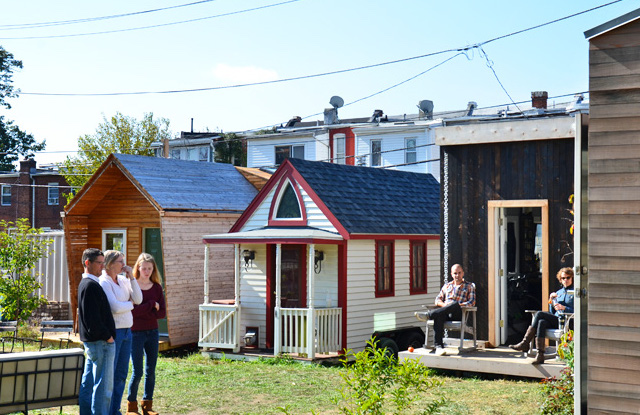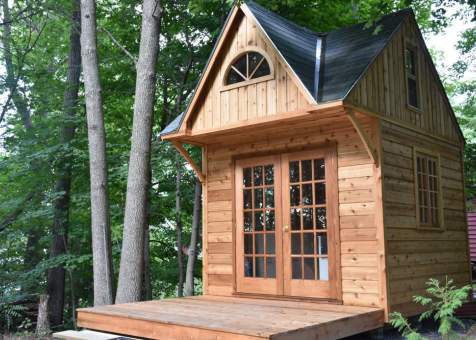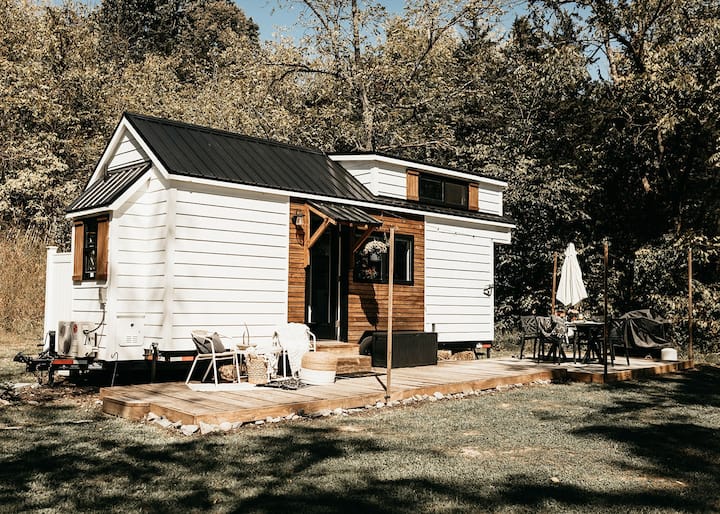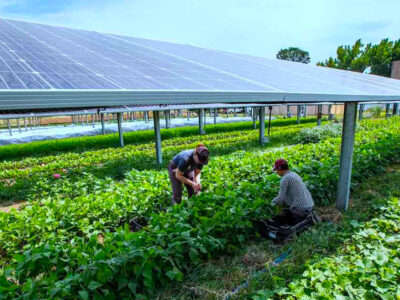Our homes have an important part to play in meeting the 2030 carbon reduction targets set out by many countries. Alternatives like Earthships, modular homes and passive houses can really reduce the carbon footprint of our dwellings, but they aren’t affordable for most people yet. What if we could build houses that require much less energy to maintain, construct, heat and cool? Let’s explore tiny sustainable houses and how they stack up against traditional homes and sustainable alternatives.
The path to decarbonizing requires major changes from most industries. Renewable energy and electric vehicles are only a few pieces of the decarbonization puzzle. We can have a big impact on climate change with the way we build our houses and the energy we use in them. But, for most people, cost is a factor and that has to be considered as well.
In the U.S., the residential sector is responsible for about 20% of carbon emissions and accounts for 21% of all electricity consumption in the country. Here, space heating and cooling were estimated to account for 42% of U.S. homes’ energy in 2021. 1 2
In the UK, households also have a significant share of carbon emissions, accounting for 40%, and although the emissions declined from 12.8 tons in 1990 to 8.1 tons in 2014, there’s still a lot to be reduced to try and hit carbon targets over the next few decades. 3
In order to reduce the carbon footprint of homes, sustainable alternatives like passive houses, Earthships, and modular homes have become more popular. They take into consideration things like orientation, insulation, use of greener or repurposed materials, and – in the case of modular homes – off-site construction. But the larger the size of house, the more expensive and carbon-emitting it is. As a result, people have started to question if we really need big homes that demand more building materials and consume more electricity. And here in the US, we love our big homes.
Since the 1950s, the average size of a new single-family home in the U.S. has jumped from 950 square feet, which is about the size of my house built in 1954, to over 2,000 square feet. In this context, the movement of tiny houses has been gaining momentum in the home building sector as a more sustainable and affordable approach. 4
Tiny homes are typically no larger than 400 square feet, and some of these can be as petite as 80 square feet total. That’s about the size of the room I’m sitting in … I’m not sure I could live in this. They have low maintenance and energy consumption and are more affordable than traditional homes. However, it’s not just about affordability; there’s a whole movement and mindset behind the construction of these houses.
You could say small living goes back to the earliest humans, occupying caves and built-structures like igloos, tents, and huts. But that was probably more necessity than anything else. Jump forward to 1854, when Henry David Thoreau’s book “Walden” was published, detailing his experiences living for two years in the woods in a 150-square-foot cabin near Walden Pond outside Concord, Massachusetts. That’s certainly a Tiny House and probably did inspire some people to try living a more simple, uncomplicated life. But the jumpstart of the Tiny House movement is much more recent, with several books being published on the topic, including “The Small House Book” by Jay Shafer in 1999. He kicked off the first company to sell tiny mobile homes in the U.S., the Tumbleweed Tiny House Company, in California. I love that name. A few years later, Shafer and other enthusiasts of the tiny home movement founded the Small House Society, aiming to pool their knowledge together and support more research and development on small living. 5 6 7
:format(webp):no_upscale()/cdn.vox-cdn.com/uploads/chorus_asset/file/8873085/Replica_of_Thoreau_s_cabin_near_Walden_Pond_and_his_statue.jpg)
Since the mortgage crisis in 2008, the price of houses has been going up, especially during the pandemic, and the interest in downsizing and living in a more modest home has increased significantly. 5 6 8 9

Although tiny homes do live up to their name from the size perspective, they use clever designs and hacks that create multipurpose spaces for living rooms, kitchens, bedrooms, bathrooms, and essential storage. While they can be built on foundations, the concept behind tiny homes has freedom in mind so they’re commonly built on trailers or wheels, allowing owners to move to other places quickly and easily. This also avoids the need to spend money on permits or the planning permissions needed with a fixed structure. 10
:format(webp)/cdn.vox-cdn.com/uploads/chorus_image/image/55201231/Cover.0.png)
It shouldn’t be a surprise, but they can be powered by renewables like solar and wind in addition to regular grid connected electricity. Adding panels will increase the upfront cost of tiny homes, and depending on the location where owners might move to next, the number of panels may not be enough to fully power the tiny home in an off-grid situation. You can get around that by also having batteries or a backup generator, which would increase building costs. For that reason, tiny houses are often just hooked up to the local grid, rather than being fully off-grid. 11
People move to tiny houses for all sorts of reasons: financial, lifestyle, maintenance, portability, downsizing and environmental concerns. It’s a very flexible option that can fit any number of motivations. 12
When choosing a tiny home, there are two main costs to consider: economic and environmental. In terms of economics, these homes are much more affordable than traditional homes, Earthships, modular homes, or passive houses, allowing people to own their home without spending hundreds of thousands of dollars. And on the environmental front, these homes have a considerably lower carbon footprint because they’re built with fewer materials, consume much less energy and water, and produce less waste.
The average tiny house consumes only 7% of the electricity that it takes to power an average-sized house. Most tiny homes have a 30-amp power capacity, compared to the 100-200 amps required by traditional homes that may have central heat and air conditioning. In fact, a tiny house produces about 2,000 pounds of CO2 emissions yearly, while an average-sized home releases 28,000 pounds into the atmosphere. 13 14
While average-sized homes have 20-40 light bulbs, a tiny house needs only 6 light bulbs on average, and some owners choose to go without appliances that may be considered essential for most of us, like TVs, microwaves, a washer and dryer, which helps with their energy efficiency. And you can make them even more sustainable if they’re built with recyclable materials or reclaimed products like corrugated tin, reclaimed barn wood siding and windows, reused pine flooring or shipping pallets. 12 14

And, as a bonus for those of you who don’t like cleaning, living in a tiny house can be great since you’ll have much less area to clean and probably fewer things to organize. These houses can also increase a sense of community and social connections by sharing items that you or others don’t have, like a washing machine, wi-fi, or even just spending some time outside with other people.15 16 Spending time with other people … I think I remember what that was like.

The cost of tiny homes are just a fraction of the price of conventional homes. Obviously, the price will vary according to the size, interior design, whether it’s mobile or not, and the type of materials used to build it. A basic cabin kit can cost as low as US$6,000 to US$8,000, while a nicely designed tiny house can be US$100,000 or more. But the average cost of a tiny home is about US$45,000. On the flip side, Zillow estimated that the average American home, as of November 2021, was about US$300,000. 17 18
In order to compare the costs of a traditional home with a tiny house, let’s consider an owner with excellent financial credit. Take a traditional mortgage of US$250,000, with an interest rate of 4% and a term of 30 years: the monthly payment would be $1,193.54 and the total interest paid over the life of the loan is US$179,673.77. So the final cost of this house is US$429,673.77. Financing a tiny home can be tricky, since there are minimum loan amounts and some lenders require that homes have a permanent foundation. But you could get a personal loan or, in the case of mobile tiny homes, potentially get RV or trailer financing. Using that for our example, a US$60,000 tiny house loan with an interest rate of 6% and a maximum term of 15 years means the monthly payment would be US$506.31 and the total interest paid is US$31,135.80. The total cost of your tiny portable house would be US$91,135.80, considerably lower than the traditional house. 19
The biggest savings most tiny house owners have comes from the fact that they don’t have a monthly mortgage payment – 68% of tiny house owners have no home payments at all, compared to 29.3% of all American homeowners. In addition, 55% of those who convert to the tiny house movement have more savings than the average American, and 65% have no credit card debt. Most who live in tiny homes spend about US$10 to US$35 a month on all their utilities, while an average-sized house usually has monthly utility bills of at least US$240. 7 20 My utility bill says hello.
When you look at other types of sustainable homes, tiny houses are more affordable. While they have an average cost of US$150 per square foot, Earthships cost between US$150 and US$225 per square foot and passive homes cost US$166 to $231 per square foot, as I covered in previous videos. However, other costs need to be considered when building a tiny house, like building permits, which generally costs about US$1,350 on average in the U.S., a foundation, which costs US$4-7 per square foot, and a piece of land if you’re targeting a permanent home, and the land value will vary a lot depending on the location. 17 21
With the spread of this tiny movement, several companies have been building tiny homes around the globe, and the options range from cheap and simple cabins up to luxury homes … albeit tiny luxury homes. The Canadian company Minimaliste, for example, builds tiny houses on wheels that can feature solar-powered electric systems, propane systems, integrated drinking water, or gray water tanks that can allow off-grid life for all types of climate. The prices range from $85,000 CAD (about US$67,000) to $160,000 CAD (about US$125,000), and depending on the model, it can accommodate from 2 to 8 people. 8 people … living in a tiny house … that sounds like a reality tv show.
On the other end of the spectrum, there are also very cheap options, like the Bala Bunkie cabin, built by the U.S.-based company Summerwood. This cabin design has 230 square feet of usable space but the clever design has a footprint of only 100 square feet, and it comes with an increased roof pitch to create plenty of loft space. The kit price costs US$10,636, and in most jurisdictions it doesn’t require a permit. But the cost of the Bunkie doesn’t include any insulation, or the addition of plumbing or electrical. You’re literally just buying the box. But if you can get by without that – living the Walden way – this could be a bargain. 22

In the UK, Tiny ECO Homes UK builds towable eco mobile homes in three ranges: Traditional, Elegance and Elegance Grand. The prices range from £42,000 to £62,000, with sizes from 144 up to 224 square feet. Their tiny houses are more on the luxury end of the spectrum for people who want to downsize without giving up comfort. Their Traditional range tiny home features double glazed windows and door, thermally treated exterior cladding, LED lighting and electric throughout, several appliances, and the bathroom includes a luxury steam spa shower cubicle. 23 That sounds nicer than my house.


Not only has the tiny home movement been gaining traction around the world, it’s gaining traction online. You can buy a tiny home on Amazon! I wonder if they deliver it next day. But that may not be a purchase you want to make sight unseen. If you’re interested in tiny home living but aren’t sure it’s right for you, you could simply rent one to test it out. In the U.S. there are more than 7,000 tiny homes available for rent on Airbnb. For example, you can rent this 1-bedroom tiny retreat near Ski-Roundtop in Wellsville, Pennsylvania, for $161 a night. You can try out several options this way before making your decision to go all in on small living. 24 25


Even though the tiny house movement has been gaining popularity, there are still some issues to be considered. In the US there are many different laws regarding zoning regulations of tiny homes varying by state, city, and town. In most areas, these homes need to have a minimum ceiling height of 6-feet-4-inches in bathrooms and 6-feet-8-inches in common areas to ensure safety. In addition, the need to have at least one separate bathroom, an emergency exit, a staircase or ladder that leads to any lofted spaces, but those requirements vary depending on where you’re building or parking your tiny home. The 10 most popular states in the U.S. for tiny home living are Utah, New York, North Carolina, Arizona, Washington, Oregon, Texas, Colorado, Florida, and California. 26 27
Tiny homes have become an interesting asset in the building sector that can help drag carbon emissions down, or just save you a lot money in how you live. The tiny home market is set to grow by US$3.33 billion, at a CAGR of over 4% through 2025. 28 With the increased interest in tiny living, no matter what your underlying motivations are, builders are popping up around the globe to fill that need. Now, I don’t know if I could live in one (it’s too small for my family), but it could be a great option for you.
- CARBON FOOTPRINT FACTSHEET↩
- Home Energy Use↩
- The Fifth Carbon Budget↩
- Could tiny homes be the adorable, affordable and sustainable housing that our planet needs?↩
- The History and Evolution of Tiny Homes↩↩
- Tiny house movement timeline: A brief history of tiny homes↩↩
- What Is The Tiny House Movement?↩↩
- A tiny house movement timeline↩
- Tiny Homes↩
- What is a Tiny House? Introducing the Tiny House Movement↩
- Electricity for Tiny Houses: Choosing Renewable Sources to Reduce Your Carbon Footprint↩
- Benefits of a Tiny Home: Everything You Need to Know About the Eco-Friendly Houses↩↩
- Sustainable and small: The tiny house movement↩
- How Much Power Does a Tiny House Use?↩↩
- What is a Tiny House↩
- 9 Benefits of Living in a Tiny House↩
- How Much Does A Tiny House Cost?↩↩
- United States Home Values↩
- What to Know About Buying a Tiny House↩
- 6 Ways a Tiny House Saves Money↩
- How Much Tiny Homes Really Cost: A Complete Guide↩
- Bala Bunkie↩
- TINY HOMES UK↩
- 7 Tiny Houses for Sale on Amazon: Buyer Beware?↩
- The Perch, a Tiny, Cozy Retreat near Ski-Roundtop↩
- What States Allow Tiny Homes and Where Are Tiny Homes Illegal?↩
- Tiny Homes Aren’t Legal in Every State — Here’s Why↩
- Tiny Homes Market 2021-2025: Industry Analysis, Market Trends, Growth, Opportunities, and Forecast | Technavio↩


















Comments